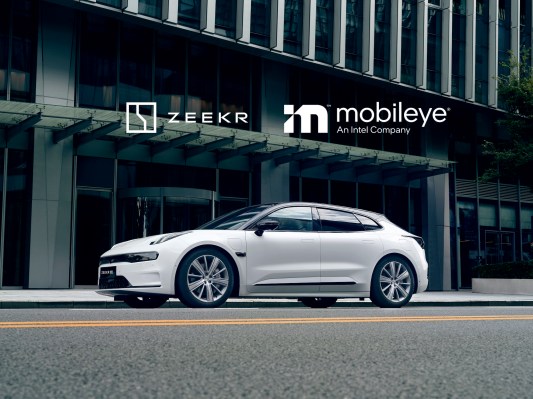Intel subsidiary Mobileye is partnering with Chinese automaker Zeekr to develop an all-electric autonomous vehicle for consumers. The vehicle will be sold in China starting in 2024 and eventually roll out to other markets, the companies said Tuesday without naming specific countries or a timeline.
The companies made the announcement Tuesday at the 2022 CES tech trade show in Las Vegas. Mobileye also announced separate deals with Ford and Volkswagen Group to use its mapping technology to support their respective advanced driving assistance systems.
The planned Zeekr autonomous vehicle will combine Mobileye’s chips with Zeekr parent company Geely Holdings’ electric vehicle architecture, which includes redundant braking, steering and power. The company didn’t show what that vehicle might look like (the main photo shown in this article is of the Zeekr 001 EV, which includes Mobileye tech).
The upcoming vehicle will have so-called Level 4, or L4, capabilities, a term that means it will be able to handle all aspects of driving for the human in certain conditions. This might mean the technology will only work on certain roadways or urban centers or when weather conditions are ideal.
The Mobileye tech will include six of its EyeQ5, or fifth generation, system on chips, which will be used to process incoming data from sensors as well as incorporate the company’s branded “Road Experience Map” mapping technology and Responsibility-Sensitive Safety (RSS)-based driving policy.
Mobileye also announced that it is scaling up research and development efforts in China with plans to open a local data center and boost with workforce there.
The Mobileye-Zeekr news comes less than a month since Waymo, Alphabet’s autonomous driving technology arm, announced it was partnering with Chinese automaker Geely to build an all-electric, self-driving ride-hailing vehicle. The companies said they would integrate Waymo’s AV system into Geely’s Zeekr vehicles for use in U.S. markets “in the years to come.”
Mobileye, best known for its chips that support advanced driver assistance systems, has also been developing automated vehicle technology for several years. Its full self-driving stack — which includes redundant sensing subsystems based on camera, radar and lidar technology — is combined with its REM mapping system and RSS driving policy.
Mobileye’s REM mapping system crowdsources data by tapping into consumer and fleet vehicles equipped with its system on chip to build high-definition maps that can be used to support ADAS and autonomous driving systems. That data is not video or images but compressed text that collects about 10 kilobits per kilometer. The mapping technology is accessed via the cloud to provide, in real time, up-to-date information on the drivable paths ahead.
Mobileye already has agreements with BMW, Nissan and Volkswagen to collect that data on vehicles equipped with the EyeQ4 chip — the most recent chip equipped in vehicles — which is used to power the advanced driver assistance system. On fleet vehicles, Mobileye collects data from an aftermarket product it sells to commercial operators. Today, it has over 1 million vehicles harvesting REM data — now up to over 25 million kilometers per day. Mobileye has used all of this crowdsourced, anonymized information to create a database of precise, high-definition maps that it has branded Mobileye Roadbook.
Mobileye is now expanding its relationship with Volkswagen Group to take the map data that is being collected and apply it to the automaker’s Travel Assist 2.5 driver assistance system. The expanded partnership was also announced at CES.
Under the agreement, Mobileye’s Roadbook will be used to increase the functionality of VW’s ADAS. For instance, where available, lane-keeping assistance will be provided in many areas without visible lane markings, according to Mobileye.
The companies said Tuesday that Roadbook-enhanced Travel Assist features will be available soon in Volkswagen, Škoda and Seat electric vehicle models based on Volkswagen’s MEB platform.
Mobileye also announced Tuesday that Ford will begin using Mobileye’s REM mapping technology in future versions of Ford’s hands-free advanced driver assistance system called BlueCruise. The companies did not share a timeline for when the mapping tech would be integrated into Ford’s ADAS system.

